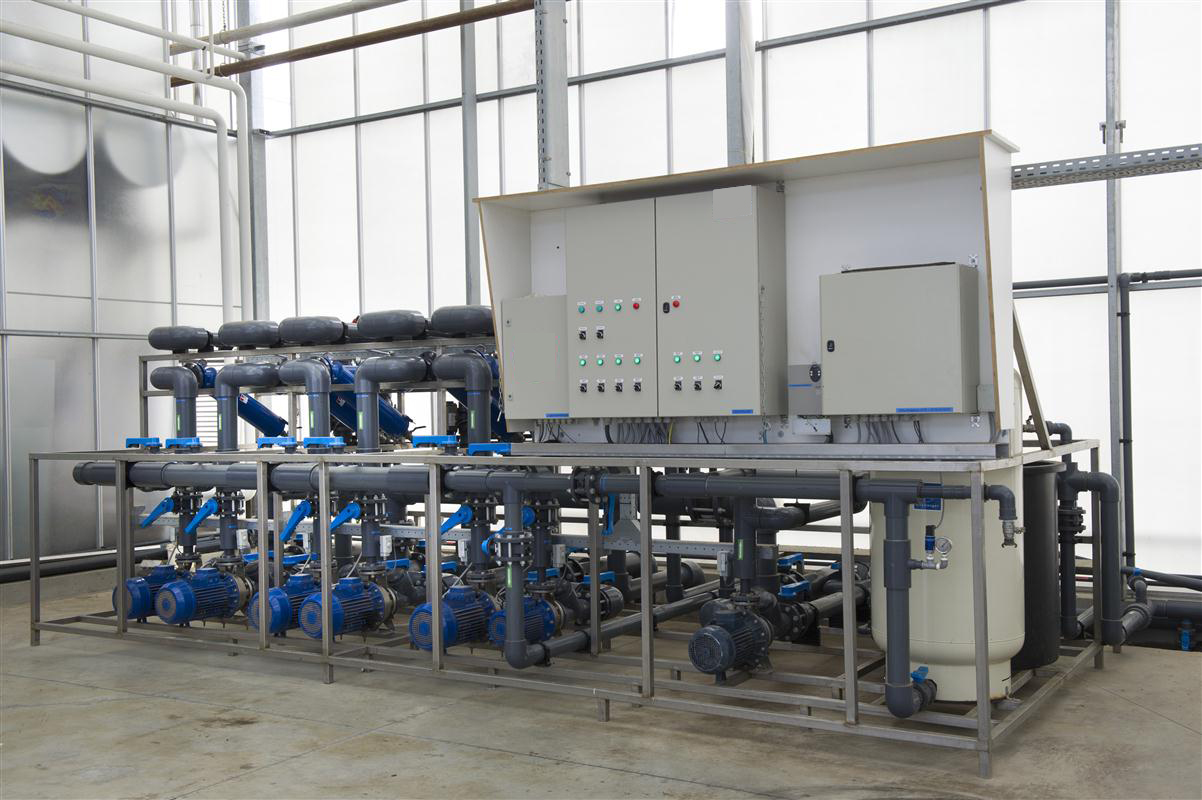The Application of Intelligent Water-Fertilizer Integration
Smart Greenhouse Water-Fertilizer Integration Equipment Greatly Improves Irrigation and Fertilization Efficiency
Water-fertilizer integration technology is a method that combines water-soluble fertilizers with water to irrigate crops. Generally speaking, it involves supplying crops with water and fertilizer after mixing them, thus ensuring the growth requirements of crops. Intelligent water-fertilizer integration technology involves incorporating modern agricultural science and technology into traditional water-fertilizer integration, using innovative equipment to mix soluble granules or liquid fertilizers according to the growth patterns of crops and the nutrient content in the soil. This results in a nutrient solution that can be scientifically, accurately, and quantitatively provided to crops at specific times.
The Current Situation of Agricultural Water Resources
In China, the effective utilization coefficient of irrigation water in farmland is far below the world's advanced level of 0.7-0.8. The grain yield per unit of water is less than 1.2kg/m3, while the world's advanced level is around 2kg/m3. Traditional agricultural irrigation is still prevalent in most of China's planting areas, leading to significant water waste and inadequate promotion of crop growth. Given the severe shortage of freshwater resources and issues such as outdated irrigation equipment and weak water-saving awareness, it is imperative to develop smart agricultural irrigation equipment with modern science and technology.
The Basic Situation of Water and Fertilizer in Vegetable Greenhouses
Chinese use of fertilizer per unit of arable land far exceeds that of other developed countries, indicating serious waste in fertilizer use. There's a saying, "A vegetable flower relies on fertilizer". Over-fertilization is common in China's vegetable greenhouses, largely due to a lack of scientific knowledge about fertilization. Many farmers believe in the adage, "More fertilizer and frequent watering, no need to ask anyone." In reality, some greenhouse farmers do not fully understand the role of scientific fertilization, and they do not pay attention to scientific fertilization, leading to waste of water resources and fertilizer without achieving the effect of increasing yield. Therefore, it is especially important to implement intelligent water-fertilizer integration technology in agriculture for the transition of old and new energy.

Advantages of Intelligent Water-Fertilizer Integration Technology in Vegetable Greenhouses
Intelligent water-fertilizer integration technology mainly uses irrigation equipment and fertilization devices as a foundation, employing control devices to proportionally mix water and fertilizer according to a specific formula, and eventually transport it to crops. The system is composed of a water source, a pressure pump, a diaphragm filter, a sand filter, a flow meter, a pressure gauge, an intelligent control platform for the water-fertilizer machine, a mixing fertilizer barrel, and a field drip irrigation pipe. Inside the greenhouse, sensors for common crop parameters are installed to collect temperature, humidity, CO2 concentration, etc., and effectively integrate them with the water-fertilizer machine. With the use of a Venturi pipe fertilizer applicator, EC, and pH detectors in the water-fertilizer machine control device, the pressure pump can enhance the mixing effect when the fertilizer is not sufficiently mixed. Four mixing barrels can add different trace element fertilizers, and through the control of the water-fertilizer machine, effective irrigation and fertilization of crops can be achieved.
Improving the Utilization Rate of Water Resources and Fertilizer
Compared to traditional flood irrigation, intelligent water-fertilizer integration technology uses drip irrigation to evenly distribute fertilizers to crops. Experiments show that the use of water-fertilizer integration technology improves water utilization by 40-60%. It saves time and labor compared to traditional flood irrigation, reduces labor costs, and is very beneficial for large-scale planting.
The intelligent water-fertilizer integration technology adopts an automatic proportional method according to plant needs, using a drip irrigation belt for irrigation. This process reduces the evaporation and loss of fertilizers and medicines, and the damage caused by soil compaction due to excess nutrients. It can also combine the expertise of local soil experts or growers to control the water-fertilizer machine for precise water-fertilizer ratios. This method of fertilization is very convenient, saves labor, and accurately uses fertilizers, reducing waste. Compared to traditional technology, the utilization rate has improved by 40-50%.
Improving Crop Quality and Yield
Most agricultural products and vegetables are prone to pest infestation, often caused by excessive humidity in greenhouses and insufficient sunlight. The use of water-fertilizer integration technology can effectively control the humidity within the greenhouse, reducing the damage pests can cause to growers. Moreover, this can significantly improve the quality of agricultural products, increasing income and reducing the cost of pesticides and manual labor.
Key Points of Intelligent Water-Fertilizer Integration Technology Application
1. Remote Control
Intelligent integrated water-fertilizer machines can adjust the irrigation plan according to the user's needs, set up a time cycle plan, and achieve intelligent control. Various pressure and flow sensors are installed in the water-fertilizer machine equipment to effectively monitor the operation of irrigation, achieving automated irrigation and fertilization, saving a significant amount of human resources.
2. Accurate Mixing Ratio of Water and Fertilizer
Combining various sensors installed in the greenhouse, the water-fertilizer integration machine can purposefully and proportionally mix fertilizers. Microelements required by crops are placed in the mixing barrel, and the water-fertilizer machine can automatically mix fertilizers according to the needs, and deliver it evenly to the crop's root growth area through the drip irrigation pipeline at a predetermined time and quantity. This process ensures the soil remains loose and does not become compacted, improving crop growth conditions.
3. Improving Crop Quality and Yield
Most vegetables are affected by soil humidity and nutrients for growth. Intelligent water-fertilizer integration technology can balance a suitable fertilizer solution and rational irrigation based on feedback from greenhouse sensors. This maintains the optimal environment required by vegetables in the soil, thereby ensuring a sustained and vigorous growth cycle for the entire crop.
Through the application of intelligent water-fertilizer integration technology in vegetable greenhouses, the production of vegetables can be effectively promoted to achieve higher yields, enhanced quality, and improved economic benefits. This will help ensure the sustainable development of the entire vegetable industry.
In conclusion, intelligent water-fertilizer integration technology is not just a technological innovation; it is a revolutionary step towards sustainable and efficient farming. As we face the challenge of feeding a growing population with limited resources, such innovations will lead the way, ensuring food security while preserving our environment. Thus, the application of such technology is crucial for the future of agriculture, globally and locally.





